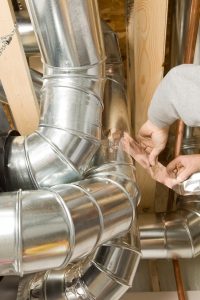When it comes to the efficiency of your HVAC system, you may not often think about the ductwork hidden within the walls, ceilings, and floors of your home. However, this network of ducts plays a crucial role in delivering conditioned air to every room. If these ducts become damaged, it can lead to significant issues such as wasted energy, increased utility bills, and a system that struggles to maintain your desired comfort level. Understanding how ductwork can get damaged in the first place can help you take proactive steps to protect your HVAC system and know when you need duct repair in Fenton, MI.
The Hidden Threats to Your Ductwork
Ductwork is designed to be durable and long-lasting, but it is not immune to damage. Over time, various factors can contribute to the deterioration of your ducts, leading to leaks and other issues that can compromise the performance of your HVAC system.
Age and Wear and Tear
As with most components of your home, ductwork experiences wear and tear over time. The material used for ducts, typically metal or flexible plastic, can degrade as it ages. Metal ducts may rust or develop cracks, while flexible ducts can become brittle and tear. This gradual wear and tear can lead to small openings that allow air to escape, reducing the efficiency of your HVAC system.
Poor Installation
Unfortunately, not all ductwork is installed with the same level of care and precision. Poor installation practices, such as using incorrect materials, failing to seal joints properly, or placing ducts in areas prone to damage, can result in weakened ductwork. When ducts are not securely fastened or are poorly sealed, they are more susceptible to damage from movement, pressure changes, and other external factors.
Pests and Rodents
Ducts that are located in attics, basements, or crawl spaces are particularly vulnerable to pests and rodents. Small animals such as mice, rats, or squirrels can chew through duct material, creating holes and gaps. In addition to causing physical damage, these unwanted visitors can leave behind debris, droppings, and even nests, which can obstruct airflow and reduce indoor air quality.
Physical Impact
Ductwork can also be damaged by physical impact. This can happen during home renovations, when workers may inadvertently cut or crush ducts while installing new electrical wiring, plumbing, or other systems. Even homeowners attempting DIY projects, like drilling into walls or ceilings, can accidentally puncture ducts, leading to air leaks.
Temperature Fluctuations
Ducts located in unconditioned spaces, such as attics or basements, are subject to extreme temperature fluctuations. In the winter, the cold can cause metal ducts to contract, potentially leading to cracks or joint separations. During the summer, the heat can cause expansion, which can weaken the ducts over time. Additionally, condensation can form on ducts in humid environments, which may result in rust or mold growth.
Excessive Air Pressure
Your HVAC system is designed to deliver a certain amount of air pressure through the ducts to heat or cool your home efficiently. However, if the system is improperly sized or if there is a blockage in the ducts, it can create excessive air pressure. This increased pressure can strain the ductwork, leading to leaks or even causing sections of the ductwork to disconnect entirely.
If you suspect that your ductwork may be damaged, don’t hesitate to contact our team of experienced HVAC professionals. Taking care of your ducts today can save you money and headaches in the long run.
First Choice Heating & Cooling serves Fenton and the surrounding areas. If your home had a voice … it would call First Choice!

